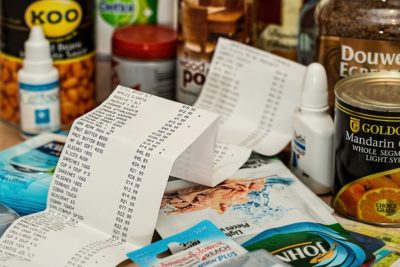by Jo White and Suz Rogers

By early March 2020 the coronavirus had gained traction globally and the threat to the UK population was increasingly being covered in the media. This saw some panic buying behaviour, initially for toilet paper and essentials such as pasta and bread, which was also widely reported in the media possibly fuelling the perceived need to stockpile food and certain essentials. What drives panic buying? How can we apply an understanding of consumer behaviours to prevent it happening again? What might the legacy of this pandemic be for consumer practices? We explore these questions in this article.
Panic buying or just buying?
The first question to consider is whether panic buying is an accurate description of the increased purchasing behaviour that was seen. We shouldn’t assume that everyone who bought essential supplies in early March was panic buying; some people live day-to-day with their shopping for either financial or life style reasons, while others live with well-stocked cupboards that would enable them to survive with minimal additions for a month before buying further provisions. If people in these different situations buy even a little more than usual, we would expect to see a significant impact when such behaviour is performed in a large proportion of the population. This line of thinking is described in this article, which mentions that data from research company Kantar suggests a 16% average increase on people’s weekly supermarket spend.
This increase in general supermarket shopping would have been exacerbated further when the restrictions were increased as more meals were eaten at home (as a result of children being at home, people working from home and therefore not buying lunch in the working day, and also eating out in restaurants). However, it is likely that some people did buy significantly more than they really needed. Sadly, this was also shown when within two weeks of the initial period of panic buying there were reports of large quantities of unused perishable food being thrown away.
Is panic buying a rational response?
 Our purchasing decisions are a combination of rational and emotional decision making, as this is how we as animals have evolved. In the case of the coronavirus pandemic, people may feel a sense of urgency and fear for the future and that of their loved ones. This fear and anxiety sends us into problem solving mode, rooted in our need to have a sense of control. This is where we may use our ‘rational brain’ to work out what we need to deal with this emergency; there are many examples of people preparing for natural disasters such as floods and hurricanes.
Our purchasing decisions are a combination of rational and emotional decision making, as this is how we as animals have evolved. In the case of the coronavirus pandemic, people may feel a sense of urgency and fear for the future and that of their loved ones. This fear and anxiety sends us into problem solving mode, rooted in our need to have a sense of control. This is where we may use our ‘rational brain’ to work out what we need to deal with this emergency; there are many examples of people preparing for natural disasters such as floods and hurricanes.
The challenge comes when we are trying to think about what we really need but are also behaving in the moment – in the supermarket. Although it might be rational and sensible to have provisions to cope with self-isolation, particularly if you are in a position where you don’t have others to easily provide you with what you need, it is not rational to fill your car with toilet roll, buy enough pasta to last a month or more, or purchase multiple packs of hand sanitizer.
The economic scientist Daniel Kahneman talks about ‘thinking fast and slow’, where part of our decision-making is based on emotions and part on rational thought. We have evolved to utilise emotional thinking as it is quick and reactive and keeps us out of danger. Indeed, it is our emotional thought that helps us to avoid being eaten by a wild animal for example. Conversely, thinking rationally (system 2) requires mental energy, it is very conscious and as a result it is slow, but it enables us to make thought-out, rational decisions. So in the case of going to the supermarket to buy provisions during the coronavirus pandemic, although it might be rational to have enough food and everyday items such as toilet roll to last a week, or perhaps the 14 days of self-isolation, buying twice as much or much more is not rational – we have switched into our emergency, emotional way of thinking.
The influence of others
Another reason that might trigger panic buying behaviours is our response to what we see other people doing. If we see or hear about others purchasing certain quantities of essential items, whether this is physically when in the shop or on social media and the news (reporting empty shelves and no toilet roll) then this plays on our herd instinct – “If other people are buying lots of provisions, I’d better too before I lose out”. In these times of social media, stories from Australia showing confrontations in supermarkets and other panic buying behaviour spread quickly and were apparently duplicated in other countries.
We are loss-adverse, evidence suggests that we are less impacted upon by gain than loss – so if someone gives you a £100 it will mean less to you than if someone takes £100 from you. Or in this case, if we think we will lose out on pasta or other staple products this can trigger the need to buy the product before it is too late and we lose the opportunity to do so. This might also be enhanced if we view these products as basic requirements for everyday living, or if we perceive them as important to protecting ourselves and family, such as hand sanitizer.
Shopping as a habit
Grocery shopping behaviour has a very strong habitual element. Supermarkets know this only too well and utilise this knowledge to maximise sales through careful product placement. They know that consumers like to know where to find the products they most commonly buy and so place products they particularly want us to buy in surprising, unique or unavoidable places.
Life events, however, have an effect on our habitual shopping; for example, when we move house or have a baby, or in case of emergency… What items, and in what quantity, we would normally buy without much thought, we now think about, and in the case of this pandemic it seems that this results in many of us buying more supplies.
What can be done to prevent panic buying?
All year round, supermarkets meticulously plan how much of each product they need – for example, they monitor the weather and if a weekend is likely to be sunny they will ensure they have more products suitable for BBQs than if the weather wasn’t so good. However, supermarkets struggle to manage the flow of their stocks when people are panic buying.
Hindsight is a wonderful thing, but the lessons we must learn for the future are to have mechanisms in place that trigger certain actions and mitigate risks. The key action to prevent people from panic buying is to provide reassurance that grocery supplies will not run out. This involves the government and supply chains building trust and confidence as well as demonstrating that there isn’t a risk of shortage. Communication must be clear and started before an issue for maximum mitigation.
All stakeholders need to work together – the supply chain, government and the media – to prevent instigating a sense of emergency and anxiety. Supportive media coverage of a collaborative approach to keep supply plentiful could strongly reduce the threat that people otherwise feel under.
In response to the panic buying, supermarkets have introduced some temporary limits and changes – for example, you can only buy three packets of pasta in many supermarkets. The shopping experience has itself changed to meet social distancing requirements; changing the environment through adding tape and markers to keep people apart in queues encourages the desired behaviour.
As in any situation when rules are introduced there will be some who break them or find ways to ‘get around’ them. For example, there are reports of people in the same household both going to the supermarket at different, or even the same, times! The main way to prevent this is by involving customers, creating a sense of community responsibility together with providing reassurance that there is enough for everyone. Helping people to understand what they might need and why would also help – people do not tend to closely monitor their rate of use of staples such as toilet roll or bread, as they are generally readily available. Clear messaging about how much toilet paper an average family of four could expect to use in a two-week isolation period might have helped mitigate over-buying of that product. Of course, reassurance is only appropriate if there is no threat to the supply chain and this pandemic will no doubt have highlighted some areas that could be improved in that regard.
The legacy of the pandemic
Most people are sourcing their food more locally during the pandemic than they did before the pandemic, as are many suppliers. It is likely that people might be discovering some advantages of shopping closer to home, they might be discovering smaller businesses and enjoying the shopping experience of perhaps getting weekly provisions from more than one local source. Some people might be cooking more from core ingredients as their ‘ready’ options have been less available. Campaigns promoting more local buying for a more sustainable and less environmentally damaging future might have been helped by recent events.
The increase in online shopping will likely remain after the pandemic as people who were perhaps reluctant to shop online might get used to the convenience of having food be delivered to their home. The online shopping provision is not just the domain of the big supermarkets – village shops have started home delivery services that they might find provide an increased source of revenue after the pandemic.
Perhaps most importantly, the pandemic has sparked an increased sense of community, which we as a nation, and indeed as a global community, need to continue to build on. A positive legacy of the pandemic, amongst many devastating negatives, could be more sustainable consumer practices with reduced environmental impact and this is something we can work for as we heal.
Jo was recently a guest on the FarmGate podcast discussing this behaviour.

